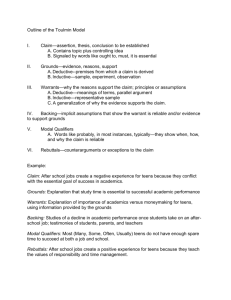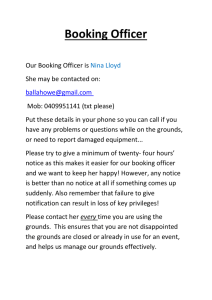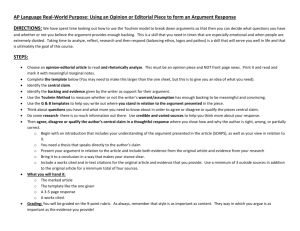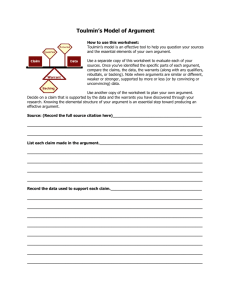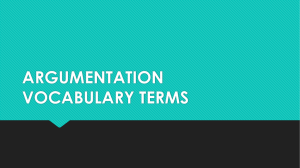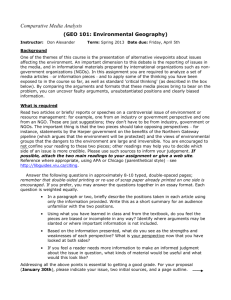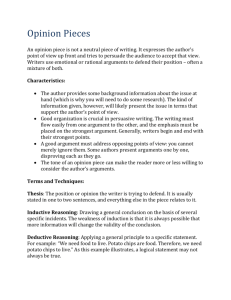Teaching Argument - Institute for Student Achievement
advertisement
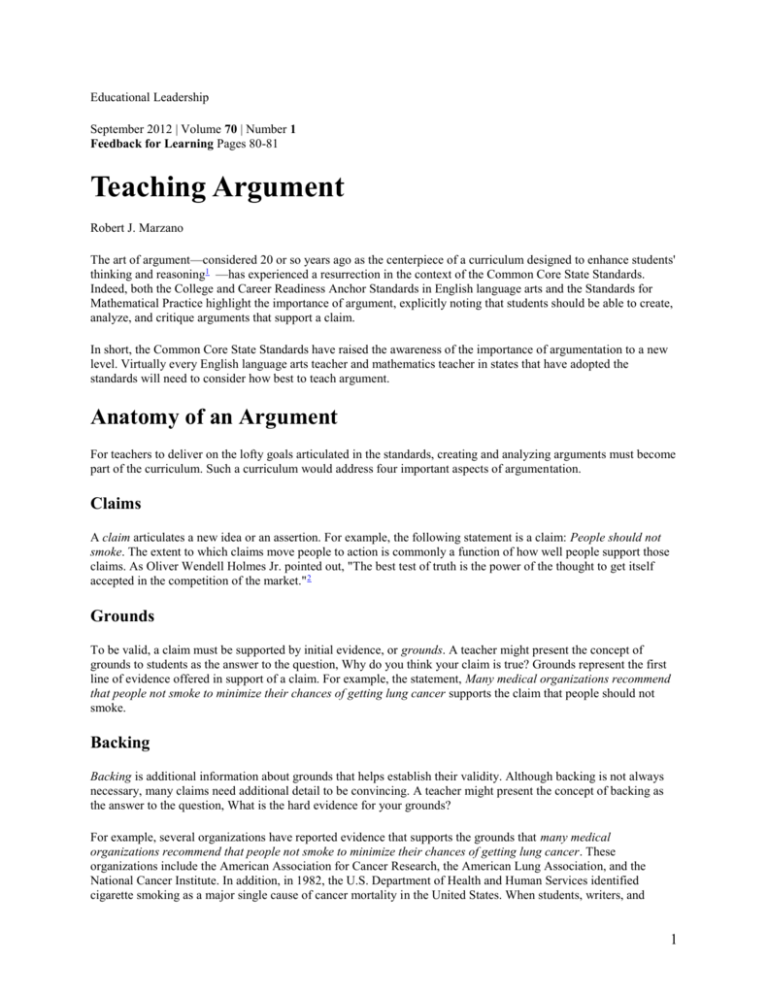
Educational Leadership September 2012 | Volume 70 | Number 1 Feedback for Learning Pages 80-81 Teaching Argument Robert J. Marzano The art of argument—considered 20 or so years ago as the centerpiece of a curriculum designed to enhance students' thinking and reasoning1 —has experienced a resurrection in the context of the Common Core State Standards. Indeed, both the College and Career Readiness Anchor Standards in English language arts and the Standards for Mathematical Practice highlight the importance of argument, explicitly noting that students should be able to create, analyze, and critique arguments that support a claim. In short, the Common Core State Standards have raised the awareness of the importance of argumentation to a new level. Virtually every English language arts teacher and mathematics teacher in states that have adopted the standards will need to consider how best to teach argument. Anatomy of an Argument For teachers to deliver on the lofty goals articulated in the standards, creating and analyzing arguments must become part of the curriculum. Such a curriculum would address four important aspects of argumentation. Claims A claim articulates a new idea or an assertion. For example, the following statement is a claim: People should not smoke. The extent to which claims move people to action is commonly a function of how well people support those claims. As Oliver Wendell Holmes Jr. pointed out, "The best test of truth is the power of the thought to get itself accepted in the competition of the market." 2 Grounds To be valid, a claim must be supported by initial evidence, or grounds. A teacher might present the concept of grounds to students as the answer to the question, Why do you think your claim is true? Grounds represent the first line of evidence offered in support of a claim. For example, the statement, Many medical organizations recommend that people not smoke to minimize their chances of getting lung cancer supports the claim that people should not smoke. Backing Backing is additional information about grounds that helps establish their validity. Although backing is not always necessary, many claims need additional detail to be convincing. A teacher might present the concept of backing as the answer to the question, What is the hard evidence for your grounds? For example, several organizations have reported evidence that supports the grounds that many medical organizations recommend that people not smoke to minimize their chances of getting lung cancer. These organizations include the American Association for Cancer Research, the American Lung Association, and the National Cancer Institute. In addition, in 1982, the U.S. Department of Health and Human Services identified cigarette smoking as a major single cause of cancer mortality in the United States. When students, writers, and 1 researchers make formal arguments (for example, in academic papers), they must provide backing that is accompanied by proper references. Qualifiers Qualifiers state the exceptions to an argument. They are important because not all arguments can be made with the same degree of certainty. Teachers might present the concept of qualifiers as an answer to the question, What are the exceptions to your claim? For example, the argument about smoking might be limited using the following qualifiers: Quitting smoking is no guarantee against lung cancer, but it does make it less likely that a person will develop the disease, and Some cases of lung cancer aren't caused by smoking. Working with Younger Students Although teachers might not wish to use terms like claims, grounds, backing, and qualifiers with younger students, they can teach and reinforce the basic structure of arguments by using four structured prompts. These work best with phenomena that students have observed in their school or home. The first two prompts might be the stopping place with primary students: "My new idea is … ": This prompt helps students generate an initial claim. For example, a primary student might state something about her pet hamsters that she has never articulated before: "My new idea is that hamsters take care of one another." "I think this is true because … ": This prompt helps students generate grounds. The student who has made a claim about hamsters might generate the grounds, "I think this is true because I saw my two hamsters sharing the running wheel in their cage." If a teacher believes that students can comprehend the concept of deeper levels of support, he or she can use the final two prompts: "I actually saw … ": This prompt helps students generate backing, the more concrete level of support. The student might say, "I actually saw one hamster get off the wheel to get a drink of water, and then the other one got on. The one who took a drink waited alongside the wheel until the other hamster got off and let him get back on again." "But I don't know … ": This prompt helps the student generate qualifiers, such as, "I don't know whether my pet hamsters share other toys in their cage. I'll have to keep looking at this." An Essential Skill To adequately teach the nature and function of arguments, educators must address these four major components. Armed with this information, students can more readily construct their own arguments and analyze the logic of others. Endnotes 1 Marzano, R. J., Brandt, R. S., Hughes, C. S., Jones, B. F., Presseisen, B. Z., Rankin, S. C., & Suhor, C. (1988). Dimensions of thinking: A framework for curriculum and instruction. Alexandria, VA: ASCD. 2 Abrams v. United States, 250 U.S. 616 (1919). Retrieved from http://scholar.google.com/scholar_case? case=14321466231676186426&hl=en&as_sdt=2&as_vis=1&oi=scholarr 2
